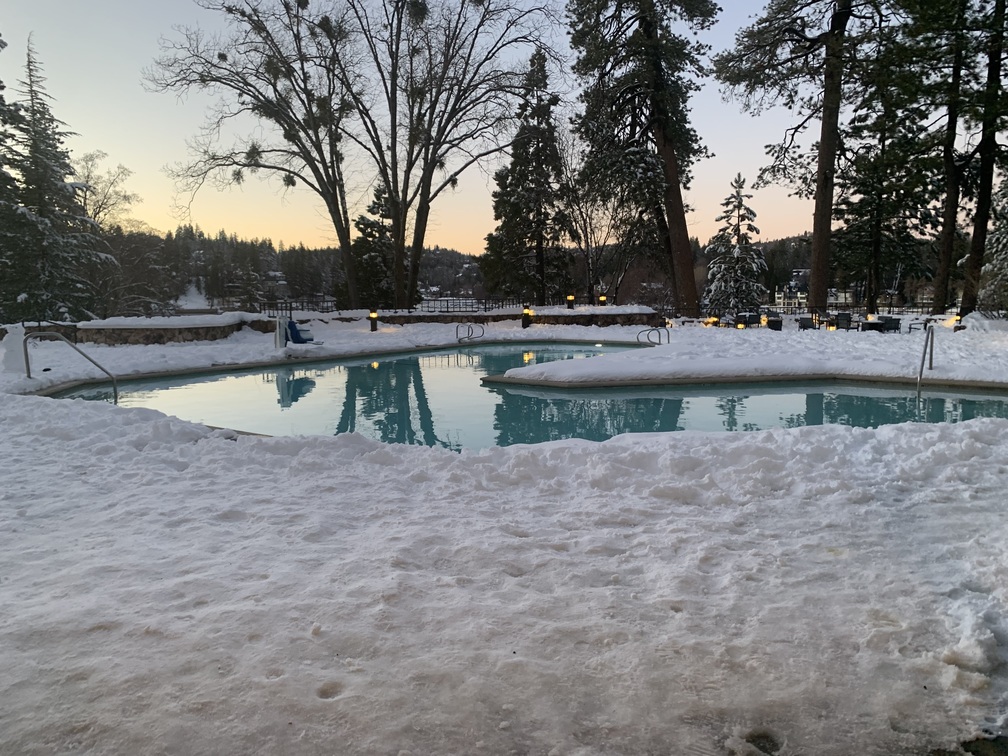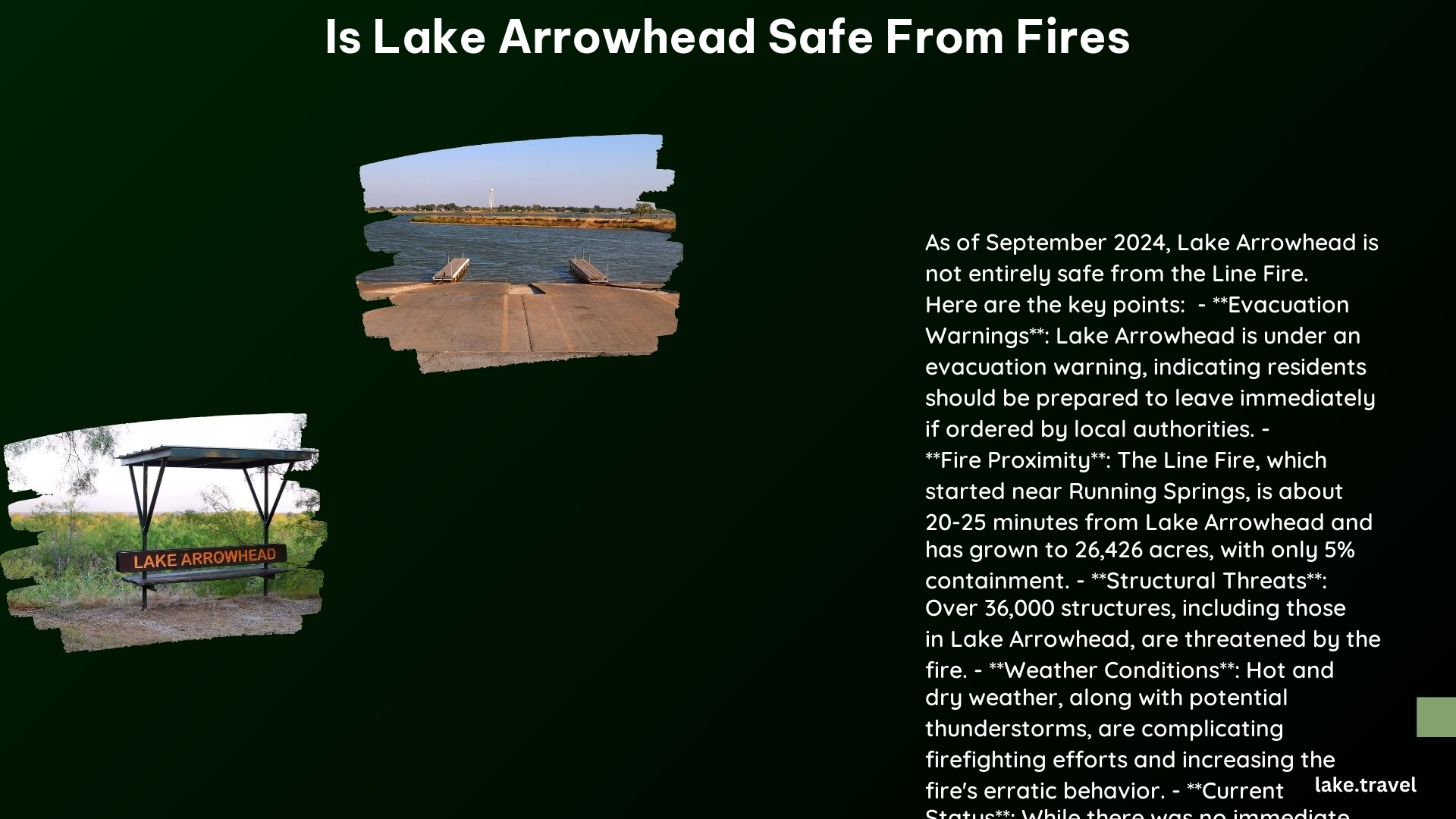Lake Arrowhead, a picturesque mountain community in Southern California, faces ongoing fire risks due to its location in a fire-prone region. The area’s safety from fires depends on various factors, including current fire conditions, prevention measures, and emergency response capabilities. This article examines the fire safety situation in Lake Arrowhead, addressing concerns about its vulnerability to wildfires and the measures in place to protect the community.
What is the Current Fire Risk in Lake Arrowhead?

As of September 2024, Lake Arrowhead is under an evacuation warning due to the Line Fire burning in San Bernardino County. The fire has grown to 39,111 acres and is 49% contained, posing a significant threat to the area. Key points about the current situation include:
- The Line Fire has threatened 36,400 structures
- One structure has been destroyed and four damaged
- Lake Arrowhead and surrounding communities are under evacuation warnings
- The fire’s proximity creates a substantial risk to the community
How Does Lake Arrowhead Prepare for Fire Safety?

Lake Arrowhead implements several fire safety measures to enhance community protection:
- Annual fire hazard abatement inspections
- Community education on maintaining defensible space
- Removal of flammable vegetation and debris
- Fire Hazard Abatement program enforcement
These measures aim to reduce fire risks and improve overall safety in the area.
What Emergency Plans Are in Place for Lake Arrowhead?
Lake Arrowhead has established emergency protocols to ensure resident safety during fire threats:
Evacuation Procedures:
- Designated evacuation routes (e.g., Highway 18 open in both directions)
- Specific evacuation zones around Lake Arrowhead
- Evacuation warnings and orders issued by San Bernardino County Sheriff’s Department
Communication Methods:
- Emergency alerts through local authorities
- Updates via local news and emergency services hotlines
- Official websites providing real-time information
Support Services:
- Evacuation shelters set up (e.g., Santa Barbara County Fairgrounds, Immanuel Baptist Church)
- Resources for evacuees at designated locations
How Effective is the Fire Department Response in Lake Arrowhead?
The fire department response in Lake Arrowhead is robust, with extensive resources deployed to combat fire threats:
| Resource Type | Quantity |
|---|---|
| Engines | 363 |
| Water Tenders | 41 |
| Helicopters | 14 |
| Hand Crews | 86 |
| Total Personnel | 3,684 |
This significant deployment ensures a rapid and effective response to fire incidents in the area.
What Fire Prevention Systems Are in Place?
Lake Arrowhead employs several fire prevention systems to minimize fire risks:
- Defensible Space Inspections:
- Annual checks to ensure properties are free of fire hazards
-
Enforcement of vegetation management regulations
-
Community Education Programs:
- Training on creating and maintaining defensible space
-
Information on fire-resistant landscaping and building materials
-
Infrastructure Improvements:
- Regular maintenance of fire hydrants and water supply systems
- Upgrades to emergency communication networks
How Does Lake Arrowhead’s Geography Affect Fire Safety?
Lake Arrowhead’s mountainous terrain presents unique challenges for fire safety:
- Dense forests increase fuel load for potential fires
- Steep slopes can accelerate fire spread
- Limited access roads may complicate evacuation efforts
- Varying wind patterns can unpredictably influence fire behavior
These geographical factors necessitate specialized fire prevention and response strategies.
What Role Do Residents Play in Fire Safety?
Residents of Lake Arrowhead are crucial partners in maintaining fire safety:
- Property Maintenance:
- Regular clearing of dry vegetation
- Pruning trees and shrubs away from structures
-
Removing dead leaves and debris from roofs and gutters
-
Emergency Preparedness:
- Creating and practicing family evacuation plans
- Assembling emergency kits with essential supplies
-
Staying informed about local fire conditions and alerts
-
Community Involvement:
- Participating in local fire safety workshops
- Supporting neighborhood watch programs
- Reporting potential fire hazards to authorities
How Has Climate Change Impacted Fire Risk in Lake Arrowhead?
Climate change has significantly influenced fire risk in Lake Arrowhead:
- Extended drought periods increase vegetation dryness
- Higher average temperatures contribute to longer fire seasons
- Extreme weather events, such as strong winds, exacerbate fire spread
- Changes in precipitation patterns affect forest health and fire susceptibility
These climate-related factors have heightened the importance of proactive fire safety measures in the area.
What Technologies Are Used for Fire Detection and Prevention?
Lake Arrowhead employs various technologies to enhance fire safety:
- Early Warning Systems:
- Smoke detection cameras monitoring forested areas
-
Weather stations providing real-time data on fire-conducive conditions
-
Mapping and Modeling:
- GIS technology for identifying high-risk zones
-
Fire behavior prediction software for strategic planning
-
Communication Networks:
- Emergency alert systems for rapid dissemination of warnings
- Integrated communication platforms for coordinating response efforts
These technological tools complement traditional fire prevention methods, improving overall safety.
Conclusion
While Lake Arrowhead faces significant fire risks due to its location and environmental factors, extensive measures are in place to enhance safety. The combination of robust fire prevention systems, emergency response capabilities, and community involvement contributes to the area’s resilience against fire threats. However, residents and visitors must remain vigilant, especially during high-risk fire seasons, and stay informed about current conditions and safety protocols.
